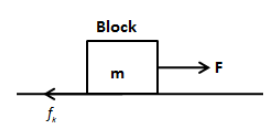
A block of mass $5 kg$ lies on a rough horizontal table. A force of $19.6 N$ is enough to keep the body sliding at uniform velocity. The coefficient of the sliding friction is
A. $0.5$
B. $0.2$
C. $0.4$
D. $0.8$
Answer
555.6k+ views
Hint: For the uniform motion, the acceleration of the body is zero. Apply Newton’s second law of motion on the block to determine the net force. Use the formula for friction force to determine the coefficient of the sliding friction.
Formula used:
\[{F_{net}} = ma\]
Here, m is the mass and a is the acceleration.
\[{f_k} = {\mu _k}mg\]
Here, \[{\mu _k}\] is the coefficient of sliding friction (kinetic friction) and g is the acceleration due to gravity.
Complete step by step answer:
We have given the mass of the body is \[m = 5\,{\text{kg}}\] and the applied force on the body is \[F = 19.6\,{\text{N}}\]. As given in the question, the applied force on the body keeps it in the uniform motion. Therefore, we have the velocity of the body is constant.We know that for uniform linear motion, the acceleration of the body is zero. Let’s draw the forces acting on the body of mass m as shown in the figure below.

Applying Newton’s second law of motion on the above block, we get,
\[{F_{net}} = ma\]
\[ \Rightarrow F - {f_k} = ma\]
Here, \[{f_k}\] is the kinetic friction.
Since the acceleration of the body is zero, the above equation becomes,
\[{f_k} = F\] …… (1)
We know the expression for the kinetic friction,
\[{f_k} = {\mu _k}mg\] …… (2)
Here, \[{\mu _k}\] is the coefficient of sliding friction (kinetic friction) and g is the acceleration due to gravity.
Using equation (2) in equation (1), we get,
\[{\mu _k}mg = F\]
\[ \Rightarrow {\mu _k} = \dfrac{F}{{mg}}\]
Substituting 19.6 N for F, 5 kg for m and \[9.8\,m/{s^2}\] for g in the above equation, we get,
\[{\mu _k} = \dfrac{{19.6}}{{\left( 5 \right)\left( {9.8} \right)}}\]
\[ \therefore {\mu _k} = 0.4\]
Therefore, the coefficient of kinetic friction is 0.4. So, the correct answer is option C.
Note: Drawing the free body diagram of the forces acting on the body always eases in determining the net force acting on the body. Always remember, the direction of frictional force is always in the opposite direction of the applied force. If the frictional force is greater than the applied force, the body does not move.
Formula used:
\[{F_{net}} = ma\]
Here, m is the mass and a is the acceleration.
\[{f_k} = {\mu _k}mg\]
Here, \[{\mu _k}\] is the coefficient of sliding friction (kinetic friction) and g is the acceleration due to gravity.
Complete step by step answer:
We have given the mass of the body is \[m = 5\,{\text{kg}}\] and the applied force on the body is \[F = 19.6\,{\text{N}}\]. As given in the question, the applied force on the body keeps it in the uniform motion. Therefore, we have the velocity of the body is constant.We know that for uniform linear motion, the acceleration of the body is zero. Let’s draw the forces acting on the body of mass m as shown in the figure below.

Applying Newton’s second law of motion on the above block, we get,
\[{F_{net}} = ma\]
\[ \Rightarrow F - {f_k} = ma\]
Here, \[{f_k}\] is the kinetic friction.
Since the acceleration of the body is zero, the above equation becomes,
\[{f_k} = F\] …… (1)
We know the expression for the kinetic friction,
\[{f_k} = {\mu _k}mg\] …… (2)
Here, \[{\mu _k}\] is the coefficient of sliding friction (kinetic friction) and g is the acceleration due to gravity.
Using equation (2) in equation (1), we get,
\[{\mu _k}mg = F\]
\[ \Rightarrow {\mu _k} = \dfrac{F}{{mg}}\]
Substituting 19.6 N for F, 5 kg for m and \[9.8\,m/{s^2}\] for g in the above equation, we get,
\[{\mu _k} = \dfrac{{19.6}}{{\left( 5 \right)\left( {9.8} \right)}}\]
\[ \therefore {\mu _k} = 0.4\]
Therefore, the coefficient of kinetic friction is 0.4. So, the correct answer is option C.
Note: Drawing the free body diagram of the forces acting on the body always eases in determining the net force acting on the body. Always remember, the direction of frictional force is always in the opposite direction of the applied force. If the frictional force is greater than the applied force, the body does not move.
Recently Updated Pages
Why are manures considered better than fertilizers class 11 biology CBSE

Find the coordinates of the midpoint of the line segment class 11 maths CBSE

Distinguish between static friction limiting friction class 11 physics CBSE

The Chairman of the constituent Assembly was A Jawaharlal class 11 social science CBSE

The first National Commission on Labour NCL submitted class 11 social science CBSE

Number of all subshell of n + l 7 is A 4 B 5 C 6 D class 11 chemistry CBSE

Trending doubts
What is meant by exothermic and endothermic reactions class 11 chemistry CBSE

10 examples of friction in our daily life

One Metric ton is equal to kg A 10000 B 1000 C 100 class 11 physics CBSE

1 Quintal is equal to a 110 kg b 10 kg c 100kg d 1000 class 11 physics CBSE

Difference Between Prokaryotic Cells and Eukaryotic Cells

What are Quantum numbers Explain the quantum number class 11 chemistry CBSE




